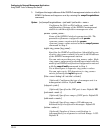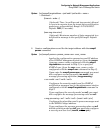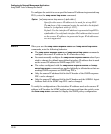
Configuring for Network Management Applications
Using SNMP Tools To Manage the Switch
5. Configure the target address of the SNMPv3 management station to which
SNMPv3 informs and traps are sent by entering the snmpv3 targetaddress
command.
Syntax: [no] snmpv3 targetaddress < ipv4-addr | ipv6-addr> < name >
Configures the IPv4 or IPv6 address, name, and
configuration filename of the SNMPv3 management
station to which notification messages are sent.
params < parms_name >
Name of the SNMPv3 station’s parameters file. The
parameters filename configured with params
<params_name> must match the params
<params_name> value entered with the snmpv3 params
command in Step 6.
taglist <tag_name> [tag_name] ...
Specifies the SNMPv3 notifications (identified by one
or more <tag_name> values) to be sent to the IP address
of the SNMPv3 management station.
You can enter more than one <tag_name> value. Each
<tag_name> value must be already associated with the
name of an SNMPv3 notification configuration entered
with the snmpv3 notify command in Step 4.
Use a blank space to separate <tag_name> values.
You can enter up to 103 characters in <tag_name>
entries following the taglist keyword.
[filter < none | debug | all | not-info | critical>]
(Optional) Configures the type of messages sent to a
management station. Default: none.
[udp-port < port >]
(Optional) Specifies the UDP port to use. Default: 162.
[port-mask < mask >]
(Optional) Specifies a range of UDP ports. Default: 0.
[addr-mask < mask >]
(Optional) Specifies a range of IP addresses as
destinations for notification messages. Default: 0.
[retries < value >]
(Optional) Number of times a notification is
retransmitted if no response is received. Range: 1-255.
Default: 3.
13-24


















